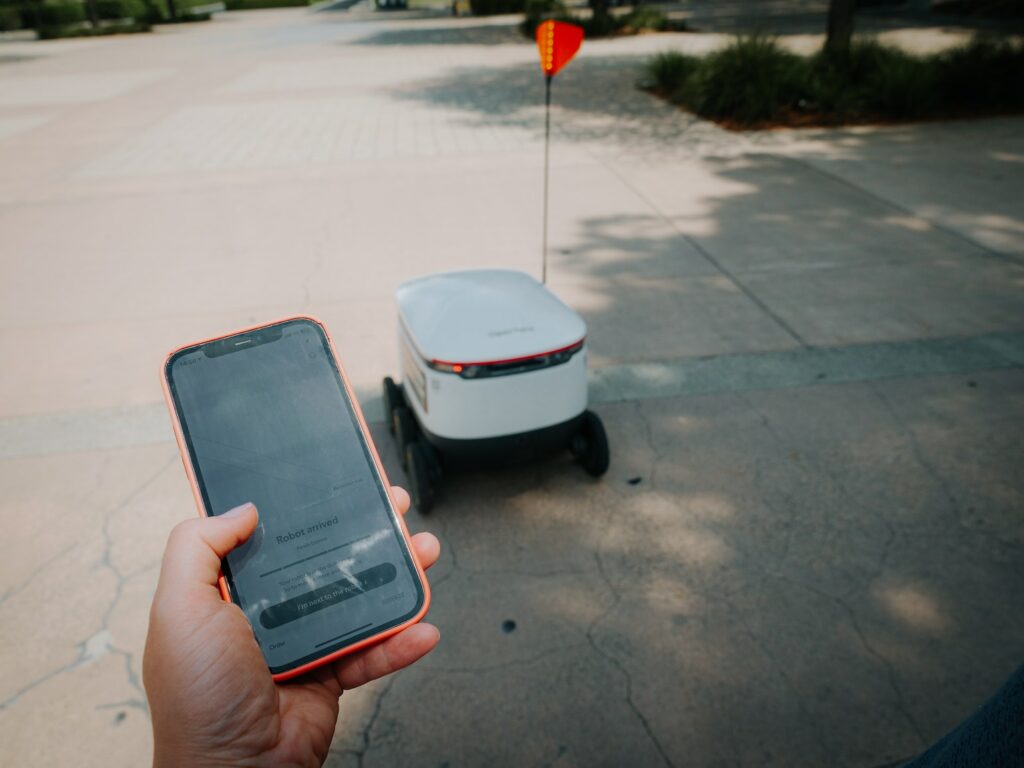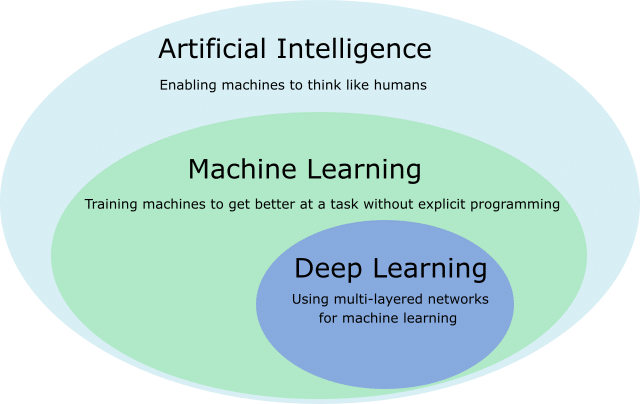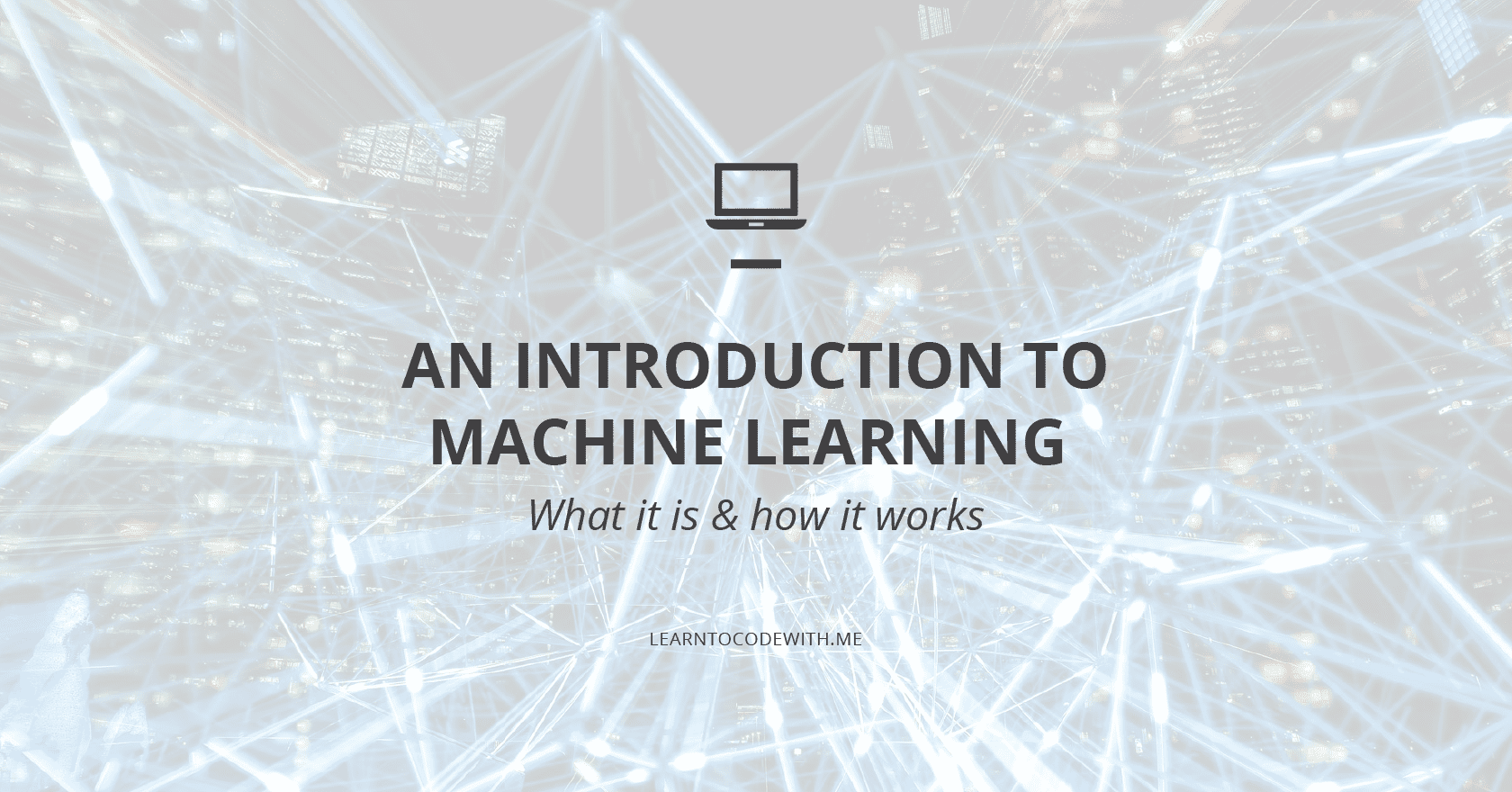What is machine learning? Essentially, it’s a way to get computers to learn and behave like humans do without being explicitly programmed to do so. Think Netflix’s recommendation engine, self-driving cars, face recognition when uploading photos to Facebook, etc.
Don’t worry — computers won’t be replacing humans anytime soon. Instead, machine learning is more of a tool that can help us solve complex problems more quickly and help us make more informed decisions.
How does machine learning work? What is the difference between artificial intelligence and machine learning? Why is machine learning important? These are all important questions!
In this post, I’ll talk more about what exactly machine learning is, what it’s used for, how it works, what the differences between machine learning, deep learning, and artificial intelligence are, and some resources to help you get started with learning machine learning.
Table of Contents
- What Is Machine Learning?
- Machine Learning vs AI vs Deep Learning
- How Does Machine Learning Work?
- What Is Machine Learning Used For?
- Where to Learn Machine Learning
Disclosure: I’m a proud affiliate for some of the resources mentioned in this article. If you buy a product through my links on this page, I may get a small commission for referring you. Thanks!
What Is Machine Learning?
Machine learning definition: Sometimes abbreviated ML, machine learning allows computers to automatically learn and improve through experience, observation, real-world interactions, and other data — without being explicitly programmed by humans. According to the University of Washington: “Machine learning algorithms can figure out how to perform important tasks by generalizing from examples. This is often feasible and cost-effective where manual programming is not.”
Since machine learning imitates the way a human learns (i.e., through practicing, understanding patterns, making mistakes, taking risks, learning from past behaviors, etc.), computers can gradually become more and more accurate at a task or set of tasks.

The term “machine learning” was first coined in 1959 by Arthur Samuel (best known for the Samuel Checkers-Player that played championship-level checkers). Earlier, in 1950, Alan Turing had also proposed a “learning machine” that could become artificially intelligent.
Fast-forward to the 1990s and machine learning started to shift from a knowledge-driven approach to a data-driven approach, so computers started to learn from vast amounts of data. In the past few decades, data-driven machine learning has continued to advance and even split off into different types of machine learning (which we’ll get into further below)!
☝️ Back to the table of contents
Machine Learning vs AI vs Deep Learning
So what is the difference between artificial intelligence (AI) and machine learning? What about machine learning vs deep learning?
Machine learning is actually a branch of AI, as is deep learning. Artificial intelligence is essentially a broad umbrella term that refers to any method used to imitate human intelligence.
Deep learning is a subset of machine learning where neural networks learn using vast amounts of data. Neural networks are computing systems modeled off of the biological neural networks that make up the human brain and nervous system.

☝️ Back to the table of contents
How Does Machine Learning Work?
There are generally three different types of machine learning methods used to train computers: Supervised, Unsupervised, and Reinforcement.
- 🧑🏫 Supervised machine learning: Feeds data to a machine learning algorithm that is clearly defined and labeled, allowing the algorithm to learn based on examples. Over time, a supervised learning algorithm will be able to see a never-before-seen example and predict a label for it based on the examples it learned from. Overall, this method is more about predicting something.
- ❓ Unsupervised machine learning: Unlike the supervised method, data fed to the machine learning algorithm is unlabeled. It’s fed a ton of data and asked to identify previously unknown patterns, trends, and structures on its own. Netflix’s recommender system is a good example of this. Overall, this method is more about finding hidden patterns in data.
- 🐕 Reinforcement machine learning: In this method, computers learn from their mistakes and trial and error. The system gets either rewards or penalties for the actions it performs. Similar to how a pet or child might learn.
For developers looking to get into machine learning, common languages/libraries to know include Python, TensorFlow, R, Scala, Julia, and C++.
☝️ Back to the table of contents
Want to master Python?
Then download my list of favorite Python learning resources.
What Is Machine Learning Used For?
So, why is machine learning important? The great thing about this field is that machine learning applications can be used in nearly every industry you can imagine (and can even be used to help save lives).

Here are just a few examples of what machine learning is used for:
- 📈 Marketing: Recommendation engines (e.g., Amazon product suggestions, streaming service movie/show recommender, Spotify playlist creators)
- 💰 Finance: insurance risk assessments or fraud detection
- 🏥 Healthcare: Making quicker and more accurate diagnoses, predicting illnesses, developing new drugs, etc.
- 🚌 Transportation: Self-driving cars, predicting traffic, optimizing routes, etc.
- 🌾 Agriculture: Predicting crop yields, soil and water management, livestock management, etc.
- 🏫 Education: Personalized learning, grading assignments, etc.
- 🏭 Manufacturing: Predicting the malfunctioning of machinery, reducing errors, etc.
And as machine learning continues to advance in the future, we’ll see even more exciting machine learning applications, like:
- 🛒 Even more customized e-commerce experiences
- 💉 More applications in healthcare (especially due to COVID-19), including early detection of diseases and new forms of treatments
- 💬 Advancements in natural language generation (NLG) (i.e., ability to produce written or spoken narrative from a dataset)
- And much more
When you decide to pursue a career in machine learning, there are so many places you could end up and so many projects you could work on — the sky’s the limit!
☝️ Back to the table of contents
Where to Learn Machine Learning
Looking to start a career in machine learning or just learn a little more about the topic? If you’re hunting for a good programming language to start building skills for machine learning, Python would be a great choice. There are also beginner-friendly machine learning courses that can explain some of the core concepts and machine learning models you’ll need to know.

Here are a few courses to get you started:
- Machine Learning Crash Course by Google: A fast-paced, practical introduction to machine learning with lectures from Google researchers. Includes 30+ exercises.
- Machine Learning, Data Science and Deep Learning with Python on Udemy: A hands-on machine learning tutorial with data science, Tensorflow, artificial intelligence, and neural networks. Excellent starter ML/data science course.
- Introduction to Machine Learning by Duke University via Coursera: Provides you with a foundational understanding of machine learning models (logistic regression, multilayer perceptrons, natural language processing, etc.).
See 13 more great machine learning courses in this post.
☝️ Back to the table of contents
Start coding now
Stop waiting and start learning! Get my 10 tips on teaching yourself how to code.
Machine Learning and You
Machine learning is a great field to get into, especially now as it’s experiencing rapid advancements and touches nearly every industry.
It’s a future-proof, exciting, and potentially world-changing field.
🤑 Not only that, but machine learning engineers earn an average of $150,336 per year, so it’s a highly lucrative field too!
That said, if you’re interested in pursuing a career in machine learning, you should know that machine learning engineer is not an entry-level job. It will work in your favor to prepare yourself for other data jobs first, starting as a data analyst or data scientist, then continuing to learn on the job and ultimately specialize in machine learning as you progress in your career.
Check out this article on Python for Data Science to get some more in-depth info (including about the Python/machine learning connection) and course recommendations!

